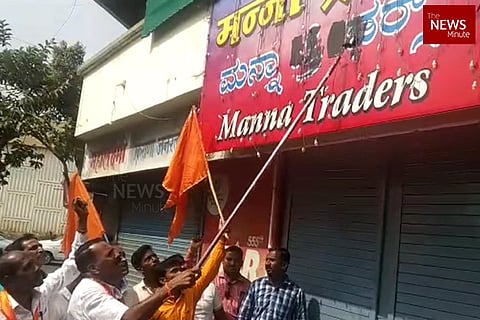

Tension and protests on both sides of the Maharashtra-Karnataka border around Belagavi over the past few days have brought back into focus the long-standing dispute between the two states over Belagavi district. On December 29, bus services from Kolhapur district in Maharashtra to Karnataka were suspended. On Sunday, Shiv Sena activists stopped the screening of a Kannada movie in Maharashtra and in Karnataka, effigies of Maharashtra Chief Minister Uddhav Thackeray were burnt. On Monday, Karnataka Chief Minister hit out at his Maharashtra counterpart, accusing him of raking up the issue again, and maintained that 'not even an inch’ of Karnataka’s land will be given away.
Every few years, this 50-year-old dispute resurfaces. What is this long-standing issue and why is it suddenly in the news again? Here’s an explainer.
The over 50-year-old dispute
Belagavi is a district in Karnataka, which borders Maharashtra’s Kohlapur district and the people living in Belagavi, also known as Belgaum, comprises both Kannada and Marathi speakers. After India became independent of the British rule, these areas around Belagavi became a part of Karnataka, when the state was formed in 1956.
Belagavi disrtict marked in red (Wikimedia Commons)
The area has been under dispute since then. In 1948, the Maharashtra Ekikaran Samiti (Ekikaran in Marathi means unification) was formed to push for the demands of the region to be merged with Maharashtra. The MES has been fighting for a merger of 800-odd villages in Karnataka with Maharashtra.
After Belagavi was included in Karnataka, Senapati Bapat, a leader from Maharashtra, sat on a hunger strike seeking that a commission be formed to address the dispute. The state of Maharashtra then petitioned the Centre, which in 1966 constituted the Mahajan Commission led by a retired judge which in 1967 recommended that 262 villages that are under Karnataka — including Karwar and 300 other villages in Karwar, Haliyal and Supa taluks, be given to Maharashtra. However, it left the city of Belagavi, then known as Belgaum, out and retained it in Karnataka. It also additionally stated that Sholapur in Maharashtra and Kasaragode, which is in Kerala, be given to Karnataka.
The Maharashtra government was not happy and called the report ‘illogical and biased.’ Karnataka, however, has since then sought that the commission report be implemented, but that has not happened yet.
Cut to 2005 — in December, the Congress government at the Centre raked up discussions again and in 2007, the Maharashtra government moved the Supreme Court. In its petition, the Maharashtra government claimed that the Marathi speaking population in Karnataka was being sidelined and there was a feeling of ‘insecurity among them.’ Maharashtra asked that 814 villages in Belgaum, Karwar, Bidar and Gulbarga districts in Karnataka be moved under their jurisdiction since it had a majority of Marathi speaking people.
That case is still being heard by the Supreme Court.
In 2012, in order to reiterate its claim over Belagavi, Karnataka government inaugurated a new Assembly building, called the Suvarna Vidhana Soudha, and is now the designated location for the winter session of the legislative assembly.
The recent events
Earlier this month, shortly after being sworn in as Maharashtra Chief Minister, Uddhav Thackeray appointed ministers Chhagan Bhujbal and Eknath Shinde as co-coordinators to oversee his government's efforts to expedite the case relating to the boundary dispute. The Maharashtra Ekikaran Samiti (MES) also submitted a memorandum of their demands to Uddhav Thackeray.
Thackeray also recently alleged in the Maharashtra Assembly that the BJP-led central government was siding with Karnataka and was ignoring Maharashtra in the Supreme Court case over the dispute.
According to reports, a few days ago, Bhimashankar Patil leader of the Karnataka Navnirman Sena, a pro-Kannada group in Karnataka, claimed that leaders of the MES should be “shot dead” on the border between the two states. Following this, members of the Shiv Sena held massive protests in several towns bordering Karnataka and had shouted slogans against Chief Minister BS Yediyurappa. They also barged into Apsara Theatre in Kolhapur and stopped the screening of Kannada film ‘Avane Srimannarayana’, starring Rakshith Shetty. They also blackened the boards which had names of restaurants written in Kannada.
Protests by the Shiv Sena
On Tuesday, Karnataka Chief Minister Yediyurappa accused Maharashtra Chief Minister of trying to create a rift between Marathi and Kannada people.
"Our people should maintain peace and brotherhood, there is no question of giving away even an inch of Karnataka's land. Just because someone made a statement there is no need to create confusion. I appeal to our people to maintain peace," he told the media.
"It has been decided in the Mahajan report what has to go to Maharashtra and Karnataka. For political benefit the Chief Minister there is trying to create confusion. I condemn it. There is no question of giving away even an inch of land," Yediyurappa added.
Meanwhile, police deployment has been increased around the border areas of Belagavi, in order to make sure that no untoward incidents take place.